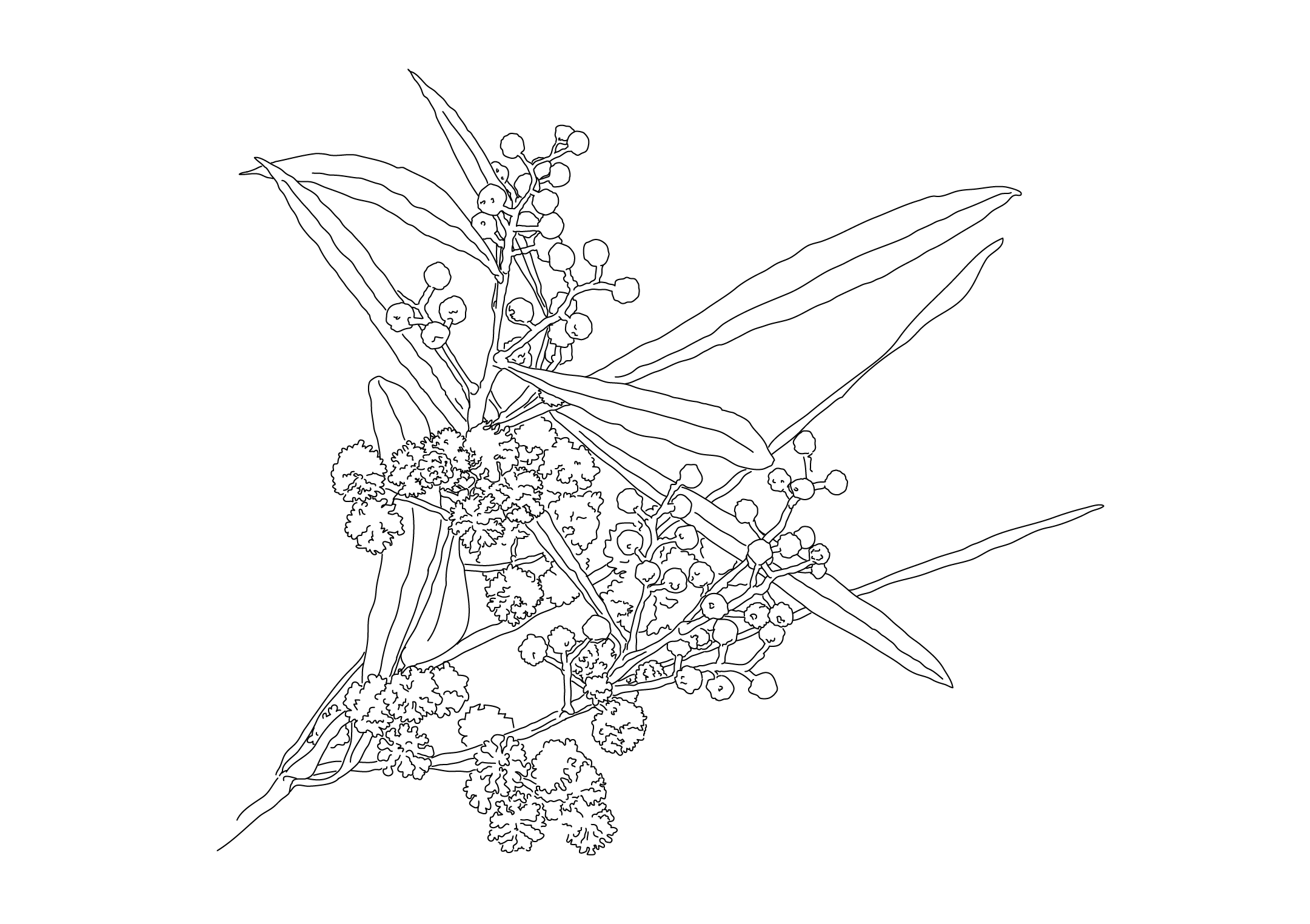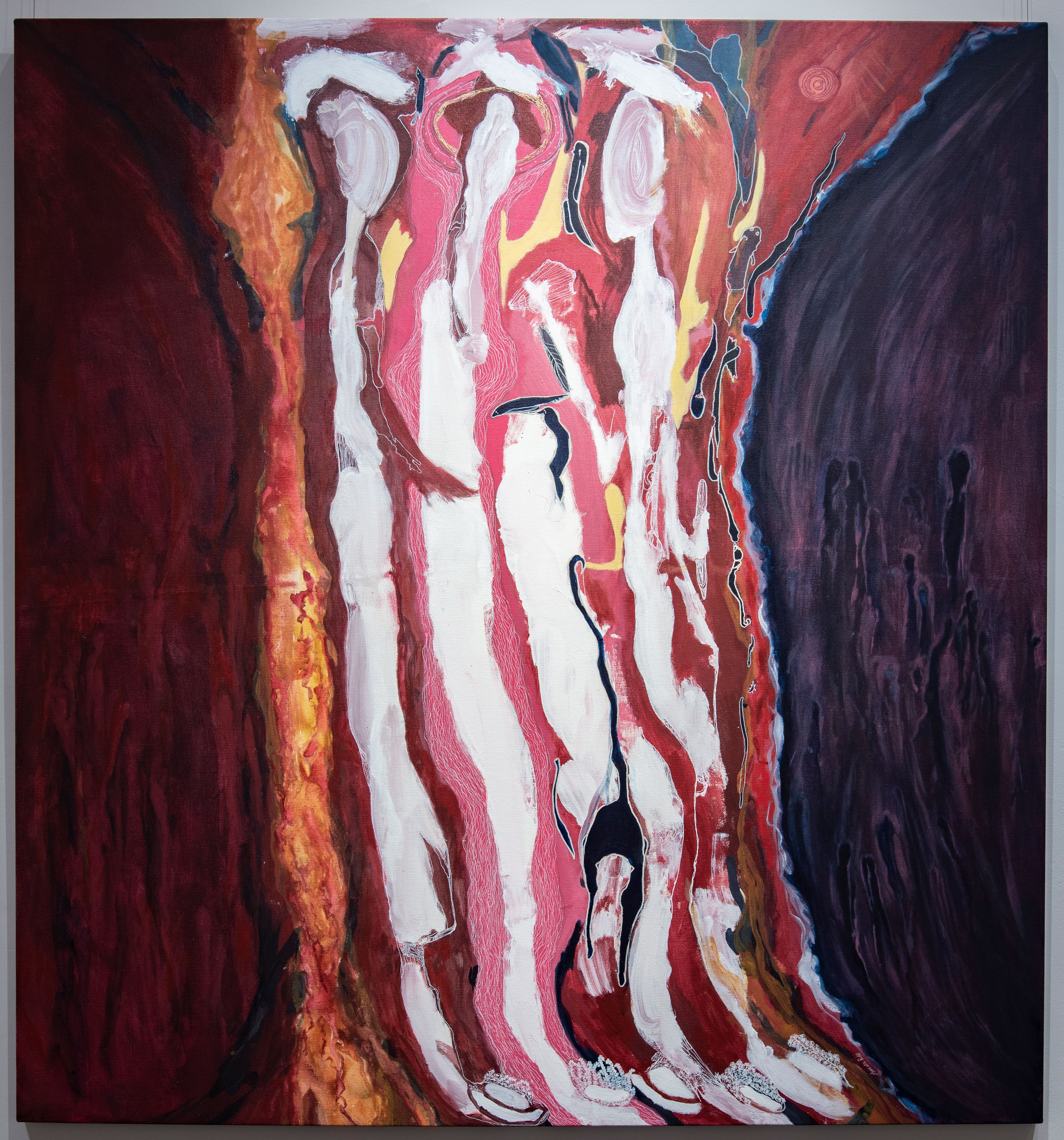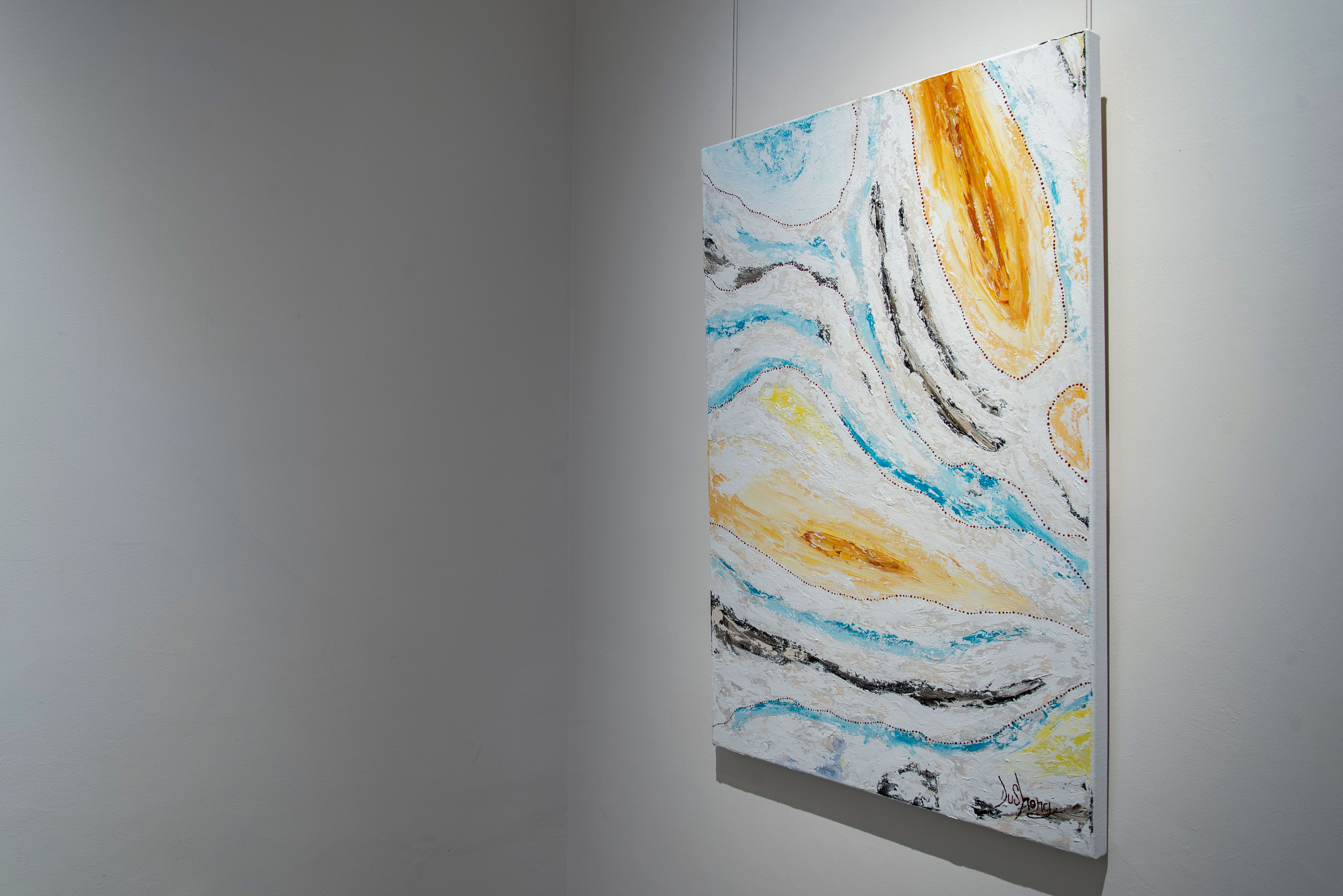Noongar Country

10 September 2020
A selection of works and texts by Amanda Bell, Arthur Graham Eades, Naomi Grant, Rohin Kickett, Yabini Kickett, Lea Taylor and Stephen Taylor from Bunbury Regional Art Gallery’s recent Noongar Country exhibition.
Noongar Country is Bunbury Regional Art Gallery’s annual acquisitional prize for Noongar artists. This year’s exhibition featured the work of Erica Anthony, Amanda Bell, Tracey Bellotti, Dellas Bennell, Lera Bennell, Eddie Bosuen, Turid Calgaret, Lisa Carter, Rod Collard, Shandell Kinjarran Cummings, Djidi Djidi Dermokalij, Arthur Graham Eades, Levon Ennies, Naomi Grant, Phillip Hansen, Elsie Hayden, Wendy Jean WendyKA Hayden, Maitland Hill, Rohin Kickett (this year’s winner), Yabini Kickett, Keira Jayne Logue, Liam Maher, Shauna Maher, Jessica Miles, Benjamin Pushman, Starsan-Rose Slater, Lea Taylor, Jo Ugle, Marjorie Ugle and Ian Vagg. There were a number of recurrent themes including love, loss, Country, family, grief, memory, and Dreaming, with the exhibition introducing a number of important new artists while highlighting the work of others with a strong and established practice. As it is every year, Noongar Country is an important way to reflect the community back to itself, finding a supportive and creative audience from Noongar Country and beyond. In this item, we share some images and text that accompanied them so readers of Semaphore can experience some of Noongar Country from a distance.
*
*

^^^ Installation view including Prohibited Area by Rohin Kickett (centre) and Arthur Graham Eades‘s Indelible Memories (right). See below for more information.

^^^ Installation view including Nganyang Kabarli Boodja by Yabini Kickett (hanging from ceiling) and Lea Taylor‘s Suspend in Time – Women’s Business (plinth, left) and Decolonised – Always Was Always Will Be (plinth, right). See below for more information.
Amanda Bell
[Adref/Homewards]Sliced between folds off- white.
Exposed a line blue-black bruised over raised pink-red,
Disappearing into yellow-red to cold-white
Proud flesh staggers, swollen and oozing pain, consuming and gasping and whispering into the fetid, medicated air
Light, all-coloured and white welcomed within……
And then the leaving
of us
No goodbyes, no need of those
We’ve had hundreds and thousands; saying, singing, calling. Sprinkled over the years
Then out, out though the open window into the outside and beyond
And then the leaving
of us
Into brothers in arms, sisters too.
And all the old people……wanting and waiting
Later, the story is told, and a line is drawn again and again, tracing its scar-raised tissue. A long journey, a long line.
Back into Country
Back to the earth
Going back Home
[Taken]Only yesterday
I was talking to some Noongars about our lives
Of loss,
Of pain,
Of theft.
And forgetting the unforgettable
We all laughed. Talked grannies, and old fellas, and the footy and food, at Christmas.
"Hey, what are you doing later?! You going that way......my way....."
only yesterday I was talking to some Noongars about our lives of loss of pain of theft
 ^^^ Amanda Bell
^^^ Amanda Bell Adref (Homecoming) (2020)
acrylic on canvas

^^^ Amanda Bell
Taken (2020)
clay and resin gum marri
Pictured (left) with Lea Taylor‘s Suspend in Time – Women’s Business (foreground) and Decolonised – Always Was Always Will Be (background). See below for more information.
Arthur Graham Eades
My name is known as Graham. This is one of my many stories of my younger years when I was growing up. My artwork is of me when I was about 9 and ½ years. I went to the Broomehill school. I remember in the class; I was talking and the teacher got very angry with me. He grabbed me by the neck and dragged me to the corner of the classroom. He put a hat over my head and pulled the hat over my eyes. The hat had “Dunce” written on it. He then began whipping me with a thin long cane, he flogged me so much, he had a good hold of my throat which almost went around my neck, I began to bleed. I was in a lot of pain, when he did let go, I took the hat off and managed to run through the classroom door and all the way home. I ran for my life. When I got home, I tried to sit down but I couldn’t. Dad asked, “What was wrong?” I told him and he had a look at all the bleeding marks on my backside. My Dad ran to the school and chased the Teacher down the road but could not catch him.
I am almost 80 years old and I can still feel the pain today after almost 70 years later, in my memory box. This one incident affected my education for the rest of my life. I hated school after that. I never got to learn and enjoy the education that I should have had.
I told my story to a lady who encouraged me to tell my story on canvas. I told her, “I have never painted in my life or sketched”, but I was encouraged to have a go. This is my painting from memory, and I hope if there is someone who had the same cruelty dealt to them, they tell someone.
Though this time of telling my story and learning to paint on canvas, has been a healing to my soul and to help me take another step in my older senior years.

^^^ Arthur Graham Eades
Indelible Memories (2020)
acrylic on canvas
Naomi Grant
[Echoes of Country]Echoes of Country is an aerial abstraction of Wiradjurri Country in NSW, the language group of my father. My aboriginal heritage is a big part of who I am. However, all my adult life has been lived in urban cities. It is easy to lose touch with the beauty and of the land, so this piece is reminding me of pattern and complexity of the land along with the simplicity and beauty of Wiradjurri Country. Even though our stories change through time and distance Wiradjurri Country always was and always will be there.
[Jamie’s Spiderboy]Jamie’s Spiderboy is all about family connection. It represents the connection to my grandson Jamie. He was four and regularly came to my studio to paint. This is a collage of his paintings ripped up and collaged to create a new piece. He named it Spiderboy upon seeing it, hence the title Jamie’s Spiderboy. I wanted to create a lasting piece of art to remember all the creative energy we had together and the connection of love we will always have. He is now six and lives in Norway. He is a passionate painter.

^^^ Naomi Grant
Echoes of Country (2017)
acrylic on canvas

^^^ Naomi Grant
Jamie's Spiderboy (2018)
acrylic and collage on canvas
Rohin Kickett
[Prohibited Area]The prohibited area highlighted in this painting is of the Perth CBD where between 1927 and 1954 Aboriginal people were not allowed without a permit from the Government. This artwork was created by shooting water balloons filled with paint to create explosion onto the canvas. The idea behind the action is that the gun represents the Government, the bullet represents the 1905 Act, and what’s left on the canvas is the aftermath and issues that stem from the Government’s policies.
[Yenyening Lakes]Yenyening Lakes is an aerial view of a portion of Yenyening lake which is situated near the town of Quairading Western Australia. The idea is to showcase the different colours shining through the salt and how much salt there is due to farming.

^^^ Rohin Kickett
Prohibited Area (2019)
acrylic on canvas

^^^ Rohin Kickett
Yenyening Lakes (2019)
acrylic on canvas
Yabini Kickett
I never got the chance to meet my maternal grandmother, but I know her Country. The few photos I have of her, show she was always well dressed. If she were still around, I’m sure she would have taught me to sew. For now, I’ve taught myself and am making her things along the way. This is the first of many works I’m making to dedicate to her, my Nanna Enid.

^^^ Yabini Kickett
Nganyang Kabarli Boodja (2020)
mixed media, textiles
Lea Taylor
[Suspended in Time – Women’s Business]Suspended in Time – Women’s Business tells the story of Aboriginal women’s practices from times past and present. The outer posts are Women’s Digging Sticks, they stand firmly in curved wandoo which is the earth. The woven basked adorned with echidna quills represents daily life for aboriginal women collecting and preparing food. All pieces are set in 3 circles, representing home.
[Decolonised – Always Was Always Will Be]In 1788 the tall ships arrived and in the name of King George III our lands were taken, our culture stripped away, forbidden. Our lives changed forever BUT we are still here; strong and proud. Our culture lives on in each of us. We have been on these lands for over eighty thousand years. Look around you, we are everywhere. No one can take what is in our blood, our DNA. I may not carry the colour of my ancestors, but they walk with me, they guide me, they give me strength. Your King may have taken our lands, but we are still here. Our culture is strong. Always was, always will be.

^^^ Lea Taylor
Suspend in Time – Women’s Business (2020)
natural and dye raffia, timber, echidna quills, ochre
Pictured in foreground with Decolonised – Always Was Always Will (background) and Amanda Bell’s Taken (left).
Decolonised – Always Was Always Will Be (2020)
mixed Media, weaving, sculpture
Stephen Taylor
[Together We Conquer]Inspired by Wardandi Boodja.
[Ochre Landscape 1]Hunting for hop. Inspired by Balladong country.


^^^ Stephen Taylor
Together We Conquer (2020)
acrylic on canvas
Ochre Landscape 1 (2020)
acrylic on canvas
Noongar Country 2020
Your mark, your story: Always was, always will be Bunbury Regional Art Gallery
29 June - 23 August 2020
For further information please see the Bunbury Regional Art Gallery website, and watch the online exhibition tour here. You can also listen to artist Amanda Bell discuss her practice with BRAG’s Education officer, Amber Norrish here.
All photographs courtesy of Bunbury Regional Art Gallery and taken by Christopher Young.
Thank you to the artists for allowing us to publish their work here again on Semaphore and thank you to the staff at BRAG, particularly Amber Norish, for working with us to put this item together.
Your mark, your story: Always was, always will be Bunbury Regional Art Gallery
29 June - 23 August 2020
For further information please see the Bunbury Regional Art Gallery website, and watch the online exhibition tour here. You can also listen to artist Amanda Bell discuss her practice with BRAG’s Education officer, Amber Norrish here.
All photographs courtesy of Bunbury Regional Art Gallery and taken by Christopher Young.
Thank you to the artists for allowing us to publish their work here again on Semaphore and thank you to the staff at BRAG, particularly Amber Norish, for working with us to put this item together.
